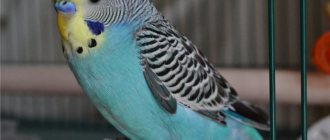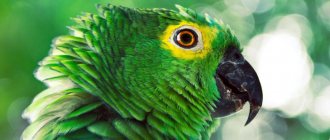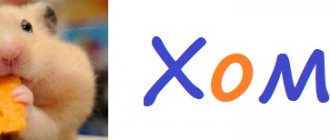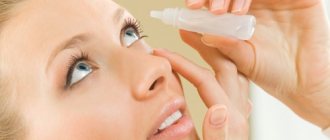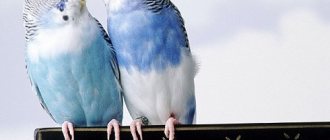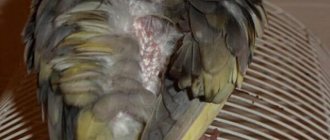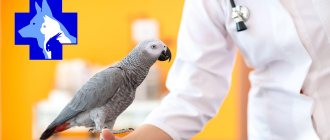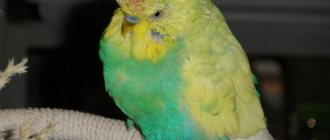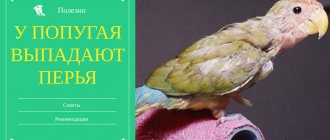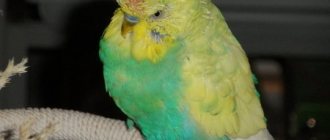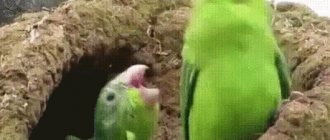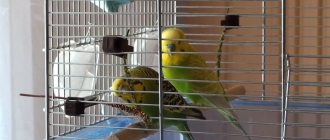The thought of why a parrot's feathers fall out occurs at least once in every poultry farmer. When a parrot loses its feathers, partially or completely, this is an alarming signal. If you do nothing, you may lose the bird. You will learn about the causes of feather loss and methods of help in this article.
Why does a parrot lose feathers?
There are many reasons that lead to a parrot going bald. Some of them are related to normal avian physiology and do not require owner intervention. However, most cases of sudden shedding of feathers indicate a disease in the bird. Sometimes it is possible to prevent further deterioration of the condition by changing the conditions in which the pet is kept and fed. Some illnesses require a visit to the veterinarian.
The main reasons why a parrot may go bald:
- natural shedding;
- avitaminosis;
- French molt;
- shock molt;
- parasitic diseases and infections;
- self-plucking;
- hormonal problems;
- microclimate disturbance.
The owner must be able to distinguish between conditions caused by different factors in order to know when it is not necessary to interfere with natural processes, when you can solve the problem on your own, and when you should contact a specialist.
Natural shedding
If your parrot's feathers have fallen out, this may mean that natural seasonal molting has begun. It goes away for the first time when the chicks reach the age of 3-5 months. At this time, juvenile down changes into adult feathers. A complete change of plumage lasts about 2 months; At this time, parrots can become aggressive and irritable, but after the process is completed, their behavior returns to normal. Adults usually molt 2 times a year - in spring and autumn; the process usually takes about 30 days. At the same time, the feathers fall out evenly, and new feathers immediately grow in their place; There are no areas of baldness.
Avitaminosis
One of the reasons why budgies go bald is due to a deficiency of vitamins and minerals. If a parrot's head goes bald, this indicates a lack of vitamins A and B in its body. In this case, the bird mainly loses feathers on its head, around the eyes and beak. With a lack of elements such as calcium, phosphorus and silicon in the diet, the parrot's feather cover becomes loose, dull and unviable, falls out easily and grows back slowly. Therefore, it is important to feed your pets a varied diet, including fresh vegetables, fruits and herbs, as well as vitamin and mineral supplements.
French molt
French molt is a serious disease that cannot be cured. It is characterized by the fact that the parrot loses feathers from its tail and wings (flight feathers, tail feathers). The bird loses the ability to fly and moves only on the floor. This disease manifests itself in chicks at the age of 3-4 months. Lost feathers may grow back, but then fall out again. The causes of French molt are not entirely clear. The disease is believed to be hereditary; in addition, it can develop with an excess of vitamin A and a deficiency of protein in the diet, as well as as a result of infectious diseases suffered at an early age.
Shock shedding
The cause of shock molting is severe stress. Budgerigars are quite sensitive birds, and many events can cause them shock. Sharp and loud noise, catching with hands and rough handling, placing another bird in the cage, changing the owner can lead to the pet starting to go bald. During shock molting, the parrot's feathers fall out in clumps, leaving large bald spots. A bird can lose both small covert feathers and large ones - tail feathers and flight feathers. After eliminating the stress factor, baldness stops and the feathers grow back.
Parasites and infections
One of the most dangerous reasons why a parrot loses feathers is infection with parasites (mites, feather eaters) or pathogenic fungi. In this case, the bird experiences severe discomfort, loses appetite, and scratches its skin. As a result, signs of inflammation, peeling, wounds and ulcers appear on the skin. Feathers become disheveled, unkempt, and brittle. When infested with mites, the back and neck most often become bald, and when there is an infestation of downy feather eaters, you may notice that the parrot has no feathers under its wings or on its belly. If left untreated, the bird may lose its plumage completely.
Self-plucking
Parrots tend to pluck their own feathers due to stress and strong emotional experiences. Self-plucking can result from:
- lack of attention from the owner;
- lack of toys, boredom;
- severe fear or constant stress;
- loud noises, sharp sounds;
- change of owner or place of residence;
- the arrival of a new family member or pet.
By plucking feathers, the parrot is trying to calm and entertain itself or attract the attention of a person. To cope with this problem, you need to create a calm environment around the bird’s cage and give the pet as much attention as possible.
Hormonal imbalances
If the owner notices that his budgerigar is without feathers, this may indicate hormonal imbalances in the bird. Most often they are observed in mature individuals, which are kept alone. Excess protein and sprouted grains in the diet provokes increased production of sex hormones. If a bird fed this diet is not allowed to breed, it will begin to lose its feathers. Baldness is also observed when the pituitary gland and thyroid gland are malfunctioning. At the same time, the growth of feathers slows down, and bald spots appear on the body. After appropriate treatment with hormonal drugs, the plumage is restored.
Microclimate
Often the cause of baldness is poor maintenance and improper microclimate in the room where the bird lives. Feather loss can be caused by:
- crowding, as a result of which the parrot rubs against the bars of the cage;
- dry air and too high room temperature;
- lack of water procedures;
- irregular cleaning, dirt in the cage;
- poisoning by toxic substances - tobacco smoke, aerosols;
- insufficient or excessive lighting, incorrect selection of lamps;
- allergic reactions to filler or food.
After eliminating unfavorable factors, the plumage is usually restored.
Physiological molting
Loss of feathers occurs in young parrots at the age of 4-5 months. If the first shedding has not begun at 5 months, a veterinarian will be required. The diet may need to be adjusted to ensure the bird is getting enough nutrients.
Juvenile
Biologists called the first change of feathers juvenile. The duration is 2-3 months, which is significantly longer than the molting of parrots in adulthood. After the process is completed, the pets become sexually mature individuals.
Treatment and prevention
If your budgerigar's feathers are falling out, you need to carefully examine it to determine the cause of this phenomenon. If the feathers fall out evenly and there are no bald spots on the body, then it is time for seasonal molting, and human intervention is not required. If the bird has become lethargic, has lost its appetite, and the feathers fall out in tufts, leaving bald patches, you should consult a veterinarian to determine the cause of the baldness.
Treatment for your pet depends on the diagnosis. Sometimes it is enough to normalize the living conditions and diet, pay more attention to the pet, or place a partner of the same species with it. In other cases, treatment with hormonal, antimicrobial, antiparasitic and other medications may be required.
To prevent loss of plumage, you must comply with all requirements for keeping and feeding the bird and properly care for it. The cage should be spacious so that the parrot can move freely around it and not touch the walls with its wings and tail. It is located in a room with good ventilation, away from heating devices and noise sources. The diet should be varied and include vitamin and mineral supplements. The owner should spend as much time as possible interacting and playing with the bird; To keep her from getting bored, toys are placed in the cage. The parrot's home is regularly washed and disinfected to prevent the proliferation of fungi and parasites.
Treating your favorite birds
What to do when a parrot loses its plumage a lot and turns into a pitiful naked carcass? Before deciding to have pet birds, the future owner needs to study the rules for keeping parrots and ensure they have a full-fledged existence. And at the first signs of illness, immediately contact a veterinarian.
Only an experienced doctor can prescribe adequate and competent treatment for parrots. The advice of experts, not the arrogance of the owner, helps to put the bird in order!
Rules for keeping parrots
The subtleties of caring for friendly and funny winged pets depend on the breed of the parrot, the size of the bird and the characteristics of its habitat in natural conditions. But there are a number of general principles, following which the owner will ensure a comfortable and healthy existence for the pet. Before buying a parrot, prepare for its arrival:
- Spacious cage. For active birds, the dimensions of the home should start from 40x25x30 cm (this is the minimum). The larger the bird, the larger the house will be - the bird needs to freely flutter around the house without touching the bars.
- Feeder, bath and drinking bowl. It is advisable to purchase a couple of containers for food - for soft and grain foods. The best material is porcelain or plastic. You will need a bath in hot weather - after each bath, change the water and clean the container.
- Chalk for birds, various sticks, sand. Choose different perches, preferably from hard wood species (birch, oak, maple). The best diameter is 1.5-2 cm. Chalk supplies the bird with calcium and helps to sharpen the beak. And the sand is poured into a tray - it is necessary for good digestion (sand can be poured into a separate feeder).
- Toys (noisy, ringing, be sure to buy a mirror). A mirror will be needed if the pet plans to live separately.
- The menu should include: grain mixture, branches of deciduous trees (linden, aspen, hazel, rowan). Vegetables, curd products, fruits, and chicken eggs. Herbs (parsley, dill, sorrel, lettuce, dandelion stems). In winter, pamper your pet with sprouted grain (give the sprouts in portions and immediately remove the leftovers).
Let's go get the parrot. When purchasing a future pet, carefully inspect the bird. A healthy bird, cheerful and curious, with clean plumage without a hint of a bald spot. The beak is smooth without defects. The eyes are not puffy, clear. A bird in good health does not cough or sneeze. It is better to purchase young chicks - they will quickly get used to new living conditions.
We place the cage. Install the pet's home away from drafts and heating devices, preferably at the level of the owner's head.
It is forbidden! Place the cage in the kitchen, install it on household appliances (computer, oven, TV, microwave, refrigerator).
The parrot's home should be well illuminated by the sun's rays, but do not overuse the light - cover part of the house with a cloth so that the parrot can hide. For birds, the optimal air temperature is +20-25⁰ C. When choosing a cage size, be guided by the breed of bird:
| Parrot species | Dwelling size | ||
| Height (cm) | Bottom (cm) | Taphole diameter (cm) | |
| Amadin, Zebra, Kakarik, Wavy | 30 | 20x20 | 7 |
| Lovebirds | 35 | 22x22 | 7 |
| Corella, Rosella | 40 | 30x35 | 9 |
| Ozherelovy, ringed breeds | 40 | 35x40 | 9 |
| Alexandrian, Amazon, Jaco, small Cockatoos | 65-95 | 45x45 | 12 |
| Large cockatoos, macaws | 125 | 95x95 | 22 |
Care. Provide your talkative pet with constant, clean, unboiled water. Change the water daily. Wash water bowls and feeders well every day, clean the cage daily. And do a general tidy up every month, and after global cleaning, treat the toys and home with chamomile infusion.
Twice a year the cage and accessories are treated with Neostomosan. After disinfection, surfaces are rinsed with chamomile decoction and thoroughly ventilated. During cleaning, the birds are placed in a separate room. Every day, let the birds fly freely around the room (make sure the windows are closed). If a parrot ends up outside in winter, it is doomed to die.
Prevention
It is easier to predict any illness than to treat it. The owner, in addition to regular care and care, should constantly inspect and monitor the playful bird. A sudden change in behavior, cough, apathy, heavy breathing, loss of appetite become a reason for an immediate visit to the doctor. Each owner should also have a first aid kit, consisting of:
- Potassium permanganate.
- Baking soda.
- Boric acid.
- Pharmaceutical chamomile.
- Activated carbon.
- Spare carrier cage.
- Hydrogen peroxide (3%).
- Pipettes and containers for solutions.
- A narrow adhesive plaster, cotton wool and a bandage.
- Sterilized vegetable oil.
- Sodium citrate (Stroud's solution).
- Anti-burn agents (ointments or aerosols).
- Curved nail scissors or nippers (for processing the beak).
- Solid wood chips according to the size of the legs and wings (in case of a fracture as a temporary measure).
Remember! Diagnosis of parrot diseases is complex and is carried out only by experienced specialists. Self-treatment can worsen the condition of your beloved pet and lead to its death. Therefore, in case of any manifestations of disease, put the parrot in a carrier and rush to the veterinarian.
Only a doctor will explain what to give the bird, how to treat it, what medications to use.
Before you go to see your doctor, write down the following information on a piece of paper. The doctor will definitely ask about this - this information helps to more accurately establish the cause of the bird’s illness:
- Pet's age.
- Where is he kept (aviary, cage).
- What illnesses has your pet already suffered?
- When did you notice the first signs of the disease?
- When and under what conditions was the parrot purchased?
- Did the bird participate in exhibitions? If yes, when and where.
- What is the parrot's diet (name of food, supplements, vitamins).
Environmental causes of baldness
For each parrot you need to choose your own microclimate, and it is not uncommon when, when any condition changes, the parrot begins to molt or go bald from the head, gradually moving to the wings, tail and chest. Examples of environmental baldness:
- Tight cage. The parrot has grown up and is physically cramped in this cage; he begins to itch himself against the bars.
- Unfavorable air environment. This also includes too dry air, especially if the cage is too close to heating devices. Also smoking or using air fresheners in the room where the parrot lives.
- Incorrect lighting. Fluorescent lamps are not suitable for parrots, and flickering lamps cause birds to become very stressed.
- Allergic reaction. Maybe they recently changed the filler and added new food to the diet, you need to undo these actions and return everything to its place.
Mite or fungus
It is not uncommon for a budgerigar's feathers to fall out due to the presence of a fungus or mite. Carefully inspect the condition of the fallen feathers. In these two cases, you can see small holes or even blood on the feathers. Scabs, ulcers, and peeling appear on the skin. The budgerigar is actively itching and plucking feathers.
You can determine the presence of a tick by placing white paper or cloth on the bottom of the cage overnight. The presence of black dots or rods indicates parasites. Only a veterinarian can diagnose fungus. During treatment, the specialist prescribes combing and application of a spray. Don't forget to thoroughly disinfect the cage.
Due to skin disease
The most common reason your parrot loses feathers is skin conditions. Of all parrots with this symptom who visit a veterinarian, 40% have the skin condition. No matter how well you take care of your parrot, there are environmental elements and things in the home that can cause problems. These may include:
- Air fresheners
- Dusty environment
- Excessive humidity
- Unsanitary living conditions
- Scented candles
If you suspect that one of the problems listed above may be causing your parrot's feathers to fall out, have it fixed immediately. Also be sure to take your parrot to the vet in case he needs any treatment for skin irritation.
Signs
- There is fluff in or under the cage. Since it is lightweight, you can see its traces throughout the room.
- After the down is renewed, the feather falls out, tubes appear, these are new feathers, which will then straighten out.
- Shedding, especially the first one, is considered stressful for a pet. Therefore, some birds even develop lethargy and decreased appetite.
- The parrot is disheveled.
- The pet begins to itch, this helps reduce discomfort and speed up the process.
- The parrot may become irritable, aggressive, and make little contact.
For some wavy cats, molting is easy, while for others it causes severe discomfort. Therefore, it is important to monitor the condition of your ward and, if necessary, contact a specialist.
Lack of vitamins
Vitamin deficiency is another cause of feather loss in a pet. A lack of vitamins can also affect the appearance of a parrot. With this disease, the intensity of growth of claws and feathers decreases, and the general condition of the bird worsens.
Most often, parrots that have an unbalanced diet suffer from vitamin deficiency. Your daily diet should include grains, fruits, vegetables, and herbs. It is also worth taking your pet to a veterinarian. The specialist will be able to prescribe a drug that contains all the vitamins the bird needs. You can purchase the medicine at a veterinary pharmacy.
Parrot molts in winter
Changing plumage in winter is quite common. Therefore, if you notice a certain amount of feathers and fluff remaining in the place where the bird was sitting, it’s okay. If your parrot sheds in winter, only ventilate it when he is not indoors. Even a slight draft or temperature change can cause disease and complicate the change of plumage. During the cold season, pet nutrition is more important than ever. He must have enough vitamins and minerals so that molting occurs without disturbances and does not harm the bird’s immunity.
If you are concerned about why your parrot molts in winter, although it has not done so before, analyze the bird’s diet, its behavior and condition. Perhaps the reason for the unplanned change of plumage was health problems or stress. However, there is no need to panic if molting occurs normally.
Many breeders are confused by the droppings when a parrot molts. Often its color and consistency change, because the pet’s metabolic processes accelerate, and foods appear in its diet that it does not consume every day. Such changes are quite natural. You should be wary if the bird has loose stools or there is blood in the droppings.
Read also: Why you shouldn’t eat fruit in the evening
Hormones
Hormones affect not only our lives, but also the life of a parrot no less.
As you know, there are a lot of hormones known, and they are produced by endocrine glands. We will be more interested in the pituitary gland and the thyroid gland (thyroid gland).
When the level of hormones drops towards deficiency or excess, this immediately affects the quality and growth of feathers.
If the problem is in the pituitary gland, then it is unlikely that anything can be done, since there is simply no treatment, but in the case of the thyroid gland, everything can be solved with simple treatment.
But don’t worry, problems with pituitary hormones are quite rare in practice, much less common than, for example, the disease that we will consider below.
What are the benefits of vitamin D?
- The most important function is to maintain our skeletal system, namely the serum levels of calcium and phosphorus in the physiological range. It is these minerals that promote bone growth and bone mineralization. This occurs due to the receptor effects of vitamin D in the duodenum: increasing the efficiency of absorption of phosphorus and calcium, the reabsorption of calcium in the kidneys from the glomerular filtrate and the differentiation of osteoclast precursors in the bones. Vitamin D deficiency can lead to bone malformations (rickets in children, osteomalacia1 in adults) and manifestations of secondary hyperparathyroidism.
- Vitamin D increases both innate and acquired immunity, participating in the activation of immune cells and triggering the synthesis of endogenous peptides (defensins and cathelicidins) with anti-infective and antitumor properties. Also, a number of studies have revealed a relationship between vitamin D levels and infectious diseases2. Against the background of reduced vitamin D levels, the level of anti-inflammatory cytokines increases, which significantly affects the effectiveness of the immune response3,4.
- Insufficient levels of this vitamin increase the risk of developing acute respiratory and intestinal diseases. And treatment regimens that include replenishment of the daily norm reduce the risk of complications due to the activation of anti-inflammatory agents.
- Do not forget that vitamin D3 regulates the activity of genes - an improvement in vitamin D3 levels contributes to a change in the severity (expression) of genes associated with the risk of developing cancer5,6 cardiovascular diseases, autoimmune disorders. 3% of the genome is affected by vitamin D.
- Vitamin D is very important for women. Low levels of this vitamin in pregnant women have a detrimental effect on embryo implantation. When performing in vitro fertilization (IVF) in patients with vitamin D3 levels within the acceptable normative range, the implantation capacity of the endometrium was higher7. There is a direct relationship between the level of this vitamin in the blood of the fetus and mother. Therefore, it is important to remember that a lack of vitamin D3 during pregnancy can negatively affect the development of the immune system and increase the risk of developing infectious diseases; in severe forms of deficiency, intrauterine fetal rickets may develop8. Also, according to research9, low levels of the vitamin in pregnant women are associated with an increased risk of miscarriage10.
Vitamin D3, 500 IU, 20 ml, Evalar
Read also: Why does a cat breathe frequently?
205 ₽
Dietary supplement NOT A MEDICINE
How does this happen?
The process of getting rid of old feathers and growing new ones takes quite a long time. The parrot sheds gradually; the bird never remains completely bald. It all starts with the fact that down and some feathers fall off from the bird. Then the amount of shed cover increases, while feathers still remain on the parrot’s body. If the feathers fall out in clumps or the bird has noticeable bald patches, consult a doctor. Shedding should not occur so quickly and cause severe discomfort to the pet.
During the molting period, a healthy bird feels well, but may behave somewhat unusually. This period is stressful for the bird, so it can either show aggression or be too quiet. It all depends on the character of the bird. As a rule, the parrot adheres to its own routine, but it wants to communicate with its owners a little less. Therefore, if you realize that your parrot is molting, do not try to take it out of the cage and pick it up.
In some situations it is worth restricting birds from flying. If you notice that a young bird is shedding old feathers on its wings, flying may become unsafe for it. She may lose her balance or be unable to land correctly.
